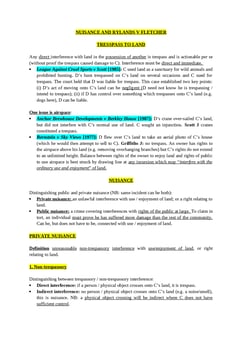Jobling v Associated Dairies Ltd [1982] AC 794
Judgement for the case Jobling v Associated Dairies Ltd
KEY POINTS
In cases involving loss of earnings, especially future earnings with a disabling illness following an injury, damages are calculated by assessing the projected income loss based on medical and economic expert testimony.
If an individual experiences a permanent partial loss of earnings due to an injury and later suffers an unrelated disabling illness, the assessment of damages from the initial injury may need adjustment. The court may consider the impact of the new illness on the individual's earning capacity, potentially altering the initial damages calculation.
FACTS
In 1973, the plaintiff had an accident while working at the defendant's shop, resulting in ongoing back pain and partial disability. He filed a damages claim based on a breach of duty under the Offices, Shops, and Railway Premises Act of 1963, seeking compensation for past and future loss of earnings.
In 1976, it was discovered that the plaintiff had an unrelated condition called myelopathy, which would eventually lead to total disability by late 1976. Importantly, this condition was dormant at the time of the accident.
During the 1979 trial, Reeve J. found the defendants liable for breach of duty but excluded the supervening disability from the damages assessment. He awarded the plaintiff £6,825 for future loss of earnings, assuming a 50 percent loss of earning capacity due to the accident.
However, the Court of Appeal allowed the defendants' appeal, reducing the damages to account for the contribution of the additional disability to the plaintiff's overall loss.
The plaintiff subsequently appealed this decision.
JUDGEMENT
The appeal was dismissed.
In assessing damages, it is imperative to consider myelopathy, which cannot be disregarded. The court's duty was to provide fair and reasonable compensation, avoiding excessiveness. All relevant factors must be taken into account.
When comparing the plaintiff's situation after the accident with what it would have been had there been no accident, it is essential to acknowledge that the supervening illness would have affected the plaintiff regardless of the accident.
COMMENTARY
In 1973, the plaintiff suffered an accident at the defendant's shop, resulting in back pain and partial disability. He sued for damages under the Offices, Shops, and Railway Premises Act of 1963, seeking compensation for past and future loss of earnings.
In 1976, it was discovered that the plaintiff had an unrelated condition, myelopathy, which would eventually cause total disability, but this condition was dormant during the accident.
During the 1979 trial, the plaintiff was awarded damages, but the Court of Appeal reduced the amount, considering the supervening disability.
The plaintiff appealed, but the appeal was dismissed. It was ruled that myelopathy had to be considered in the damages assessment, as the court's duty was to provide fair compensation, considering all factors. The supervening illness would have affected the plaintiff regardless of the accident.
ORIGINAL ANALYSIS
In 1973 Plaintiff, who was expected to work until 1985 suffered an injury due to his employer’s, Defendant’s, negligence which would reduce his capacity to work by 50% for the rest of his working life.
Independently of this, in 1975, he contracted a disease that totally incapacitated him.
Does Defendant have to pay him 50% for 3 years or 50% for 12? HL say for 3 years, since:
The myelopathy (totally incapacitating disease) could not be disregarded since the court must provide just and sufficient but not excessive compensation.
Lord Wilberforce
There are no overall rules that can govern this type of case that are universally fair and the best the courts can do is to assess just compensation on a case by case without rationalisation/exposition of universal guidelines/principles. Bad for legal certainty + inconsistency potential.
-
The “vicissitudes” argument was adopted by several judges: that the contingencies/vicissitudes of life can change a person’s fortunes and it would be wrong to ignore them when arriving at a fair settlement: the courts “should not speculate when they know” (Lord E-D).
Problem is that this fails to reconcile Jobling with Willoughby.
The House of Lords criticised the ruling in Willoughby on the grounds that it did not comply with the vicissitudes principle - Lord Reid.
The problem with the vicissitudes argument is that it prioritises “potential causes” over “actual causes”. In this case half the disability was caused by the negligence and the rest completed by the disease. If the disease had struck first then it would have been the cause, but as it happens the negligence happened first and caused half the disability. The fact that another “concurrent cause” (to use the Willoughby language) operates to complete the disability does not change what the original cause was or the fact that it is still operating: The vicissitudes argument assumes that there is only ever one cause, which is incorrect.
Lord Keith
Said that he would reconcile Willoughby with the present case by saying that Willoughby was restricted to cases where there were two tortious acts, unlike the present case.
Lords Bridge and E-D
Imply a desire to overrule Willoughby.
RELATED CASES
For Further Study on Jobling v Associated Dairies Ltd
Need instant answers? Our AI exam tutor is here to help.
Ask questions 🙋 Get answers 📔 It's simple 👁️👄👁️
Our AI is educated by the highest scoring students across all subjects and schools. Join hundreds of your peers today.
Get StartedSimilar Cases
Related Product Samples
These product samples contain the same concepts we cover in this case.
| Tort Law | Actionable Damage Notes (19 pages) |

 Since 2010, Oxbridge Notes has been a trusted education marketplace, supplying high-quality materials from top achievers at universities like Oxford, Cambridge, LSE, Harvard, and Yale.
Since 2010, Oxbridge Notes has been a trusted education marketplace, supplying high-quality materials from top achievers at universities like Oxford, Cambridge, LSE, Harvard, and Yale.